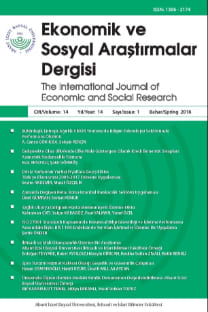ENVIRONMENTAL KUZNETS CURVE IN THE MINT COUNTRIES: EVIDENCE OF LONG-RUN PANEL CAUSALITY TEST
MINT ÜLKELERİNDE ÇEVRESEL KUZNETS EĞRİSİ: UZUN DÖNEM PANEL NEDENSELLİK TESTİNDEN KANITLAR
___
- Akbostancı, E., Türüt-Aşık, S. ve Tunç, G.İ. (2009) The Relationship Between Income and Environment in Turkey: Is There an Environmental Kuznets Curve?, Energy Policy, 37, 861867.
- Ang, J. B. (2007) CO2 Emissions, Energy Consumption, and Output in France, Energy Policy, 35, 47724778.
- Apergis, N. ve Payne, J.E. (2009) CO2 Emissions, Energy Usage, and Output in Central America, Energy Policy, 37, 32823286.
- Apergis, N. ve Payne, J.E. (2010) The Emissions, Energy Consumption, and Growth Nexus: Evidence from the Commonwealth of Independent States, Energy Policy, 38, 650655.
- Brock, A.B. and Taylor, M.S. (2010) The Green Solow Model, Journal of Economic Growth, 15, 127153.
- Chang, C. C. (2010) A Multivariate Causality Test of Carbon Dioxide Emissions, Energy Consumption and Economic Growth in China, Applied Energy, 87, 35333537.
- Canning, D. ve Pedroni, P. (2008) Infrastructure, Long-Run Economic Growth and Causality Tests for Cointegrated Panels, The Manchester School, 76 (5), 504527.
- Carson, R.T. (2010) The Environmental Kuznets Curve: Seeking Empirical Regularity and Theoretical Structure, Review of Environmental Economics and Policy, 4 (1), 323.
- Coondoo, D. ve Dinda, S. (2002) Causality between Income and Emission: A Country-Group-Specific Econometric Analysis, Ecological Economics, 40, 351 367.
- Dinda, S. (2005) A Theoretical Basis for the Environmental Kuznets Curve, Ecological Economics, 53, 403413.
- Dinda, S. ve Coondoo, D. (2006) Income and Emission: A Panel-Data Based Cointegration Analysis, Ecological Economics, 57, 167181.
- Grossman, G. M. ve Krueger, A. B. (1991) Environmental Impacts of a North American Free Trade Agreement, NBER Working Paper Series, Working Paper No 3914.
- Halicioglu, F. (2009) An Econometric Study of CO2 Emissions, Energy Consumption, Income and Foreign Trade in Turkey, Energy Policy, 37, 11561164.
- Im, K. S., Pesaran, M .H. ve Shin, Y. (2003) Testing for Unit Roots in Heterogeneous Panels, Journal of Econometrics, 115, 5374.
- Kij ima, M., Nishide, K. and Ohyama, A. (2010) Economic Models for the Environmental Kuznets Curve: A Survey, Journal of Economic Dynamics & Control, 34, 11871201.
- Pedroni, P. (1999) Critical Values for Cointegration Tests in Heterogeneous Panels with Multiple Regressors, Oxford Bulletin of Economics and Statistics, 61, 653 670.
- Pedroni, P. (2000) Fully Modified OLS for Heterogeneous Cointegrated Panels, Nonstationary Panels, Panel Cointegration and Dynamic Panels, 15, 93130.
- Pedroni, P. (2004) Panel Cointegration; Asymptotic and Finite Sample Properties of Pooled Time Series Tests, with an Application to the PPP Hypothesis, Econometric Theory, 20, 597625.
- Soytas, U., Sari, R. ve Ewing, B. T. (2007) Energy Consumption, Income, and Carbon Emissions in the United States, Ecological Economics, 62, 482489.
- Soytas, U. ve Sari, R. (2009) Energy Consumption, Economic Growth, and Carbon Emissions: Challenges Faced by an EU Candidate Member, Ecological Economics, 68, 1667 1675.
- Stern, D. I. (2004) The Rise and Fall of the Environmental Kuznets Curve, World Development, 32, 8, 1419 1439.
- World Bank (2012) Turn Down the Heat: Why a 4°C Warmer World Must Be Avoided, Washington, World Bank.
- ISSN: 1306-2174
- Yayın Aralığı: Yılda 2 Sayı
- Başlangıç: 2005
- Yayıncı: Abant İzzet Baysal Üniversitesi İktisadi ve İdari Bilimler Fakültesi
ENVIRONMENTAL KUZNETS CURVE IN THE MINT COUNTRIES: EVIDENCE OF LONG-RUN PANEL CAUSALITY TEST
Ertuğrul YILDIRIM, Zafer ÖZTÜRK
KIRILGAN BEŞLİ ÜLKELERİNDE FİNANSAL GELİŞME VE EKONOMİK BÜYÜME İLİŞKİSİ: DİNAMİK PANEL VERİ ANALİZİ
ÇEVRE İLE İLGİLİ KAMUSAL KARARLARDA SOSYAL KABULÜ ETKİLEYEN DURUMLARIN DEĞERLENDİRİLMESİ
Erol USTAAHMETOĞLU, İsmail Tamer TOKLU
TÜRKİYE'DE İÇ BORÇLANMA-EKONOMİK BÜYÜME İLİŞKİSİ: 1990-2012 DÖNEMİ ANALİZİ
ULUSLARARASI ORTAKLIK YAPISININ HİSSE SENEDİ GETİRİSİ ÜZERİNDEKİ ETKİSİ: BORSA İSTANBUL UYGULAMASI
Türkiye' de İç Borçlanma-Ekonomik Büyüme İlişkisi: 1990–2012 Dönemi Analizi
KAMU HİZMETLERİ MOTİVASYONU KURAMI: BİR LİTERATÜR TARAMASI
Özel Bir Hastanenin Tomografi Ünitesinde Maliyet-Hacim-Kâr Analizleri
